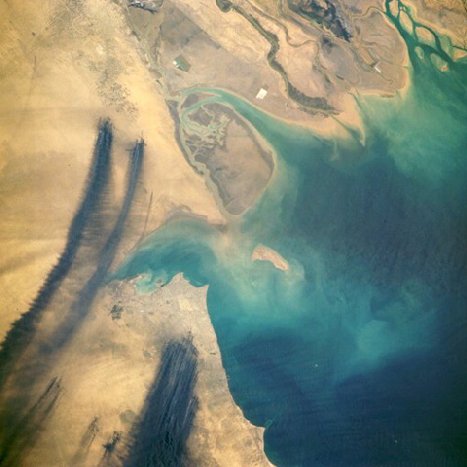| Industrial Waste |
| Modern industry and agriculture struggles to contain its waste products. Poisonous wastes such as lead from petrol have been known about for decades, but often the only solution considered has been to disperse and dilute the pollutant. Pollutants which are expected to disperse, however, are often concentrated by environmental and biological factors. Los Angeles, Mexico City and Athens have a huge problem with smog trapped over the city by surrounding mountains. Industrial and vehicle emissions produce nitrogen dioxide and ozone, both highly damaging to the respiratory system. In some countries, the introduction of catalytic converters and lead-free petrol has been effective, lowering poisonous emissions overall, even when traffic levels are increasing.
Los Angeles is surrounded by mountains to the north, northwest and east, which trap air over the city when there is a sea breeze from the west.
Oilslicks occur as a result of oil extraction and transport activities: this radar image shows where the surface of the sea has been smoothed by leaks from oil production platforms 150km (94 miles) west of Bombay. Modern farming relies heavily on fertilisers, but the nitrates in fertilisers are easily dissolved and washed into rivers. Here, river plants are over-fertilised and their decomposing remains remove oxygen from the water - a process called eutrophication, which kills off animal life. Phosphates used in detergents can have the same effect. The North Sea and Adriatic coasts have both seen "red tides" after algal blooms, which may be triggered by river and sewage water from adjacent land areas. Radioactive wastes are among the most poisonous substances known, some remaining dangerous for thousands of years. Accidents at nuclear power plants have resulted in the release of radioactive gases, liquids and particles into the local environment. The worst such accident was at the Chernobyl power station in Ukraine in 1986. Here an explosion blew off the roof of the reactor and resulted in the dispersal of radioactive material across northern Europe. The difficulty of containing and disposing of radioactive waste has proved to be an insurmountable problem for the nuclear industry in some of the most advanced nations.
Warfare took a new twist in 1991 when occupying Iraqi forces set Kuwait's oilwells alight. The smoke dominated the skies of the region for several months, polluting the air, blocking out the sun and damaging the region's harvests.
A Landsat view of the nuclear plant at Chernobyl, Ukraine, three days after it exploded in April 1986, at the north end of it's 10km-long (6.25 miles) cooling pond. The temperature hotspot (red dot) shows the burning reactor - still at 1,000 degrees Celsius |



